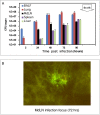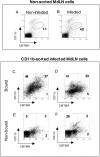Interrelationship between dendritic cell trafficking and Francisella tularensis dissemination following airway infection
- PMID: 19023422
- PMCID: PMC2582141
- DOI: 10.1371/journal.ppat.1000211
Interrelationship between dendritic cell trafficking and Francisella tularensis dissemination following airway infection
Abstract
Francisella tularensis, the etiological agent of the inhalation tularemia, multiplies in a variety of cultured mammalian cells. Nevertheless, evidence for its in vivo intracellular residence is less conclusive. Dendritic cells (DC) that are adapted for engulfing bacteria and migration towards lymphatic organs could serve as potential targets for bacterial residence and trafficking. Here, we focus on the in vivo interactions of F. tularensis with DC following airway infection of mice. Lethal airway infection of mice with the live vaccine strain (LVS) results in trafficking of a CD11b(high)/CD11c(med)/autofluorescence(low) DC subset from the respiratory tract to the draining mediastinal lymph node (MdLN). Simultaneously, a rapid, massive bacterial colonization of the MdLN occurs, characterized by large bacterial foci formation. Analysis of bacteria in the MdLN revealed a major population of extracellular bacteria, which co-exists with a substantial fraction of intracellular bacteria. The intracellular bacteria are viable and reside in cells sorted for DC marker expression. Moreover, in vivo vital staining experiments indicate that most of these intracellular bacteria ( approximately 75%) reside in cells that have migrated from the airways to the MdLN after infection. The correlation between DC and bacteria accumulation in the MdLN was further demonstrated by manipulating DC migration to the MdLN through two independent pathways. Impairment of DC migration to the MdLN, either by a sphingosine-1-phosphate receptor agonist (FTY720) or by the D prostanoid receptor 1 agonist (BW245C), resulted in reduced bacterial colonization of MdLN. Moreover, BW245C treatment delayed the onset of morbidity and the time to death of the infected mice. Taken together, these results suggest that DC can serve as an inhabitation niche for F. tularensis in the early stages of infection, and that DC trafficking plays a role in pathogen dissemination. This underscores the therapeutic potential of DC migration impairing drugs in tularemia treatment.
Conflict of interest statement
The authors have declared that no competing interests exist.
Figures









References
-
- Steinman RM, Hemmi H. Dendritic cells: translating innate to adaptive immunity. Curr Top Microbiol Immunol. 2006;311:17–58. - PubMed
-
- Forster R, Schubel A, Breitfeld D, Kremmer E, Renner-Muller I, et al. CCR7 coordinates the primary immune response by establishing functional microenvironments in secondary lymphoid organs. Cell. 1999;99:23–33. - PubMed
-
- Hintzen G, Ohl L, del Rio ML, Rodriguez-Barbosa JI, Pabst O, et al. Induction of tolerance to innocuous inhaled antigen relies on a CCR7-dependent dendritic cell-mediated antigen transport to the bronchial lymph node. J Immunol. 2006;177:7346–7354. - PubMed
-
- Jakubzick C, Tacke F, Llodra J, van Rooijen N, Randolph GJ. Modulation of dendritic cell trafficking to and from the airways. J Immunol. 2006;176:3578–3584. - PubMed
-
- Hammad H, de Heer HJ, Soullie T, Hoogsteden HC, Trottein F, et al. Prostaglandin D2 inhibits airway dendritic cell migration and function in steady state conditions by selective activation of the D prostanoid receptor 1. J Immunol. 2003;171:3936–3940. - PubMed
Publication types
MeSH terms
LinkOut - more resources
Full Text Sources
Other Literature Sources
Research Materials

